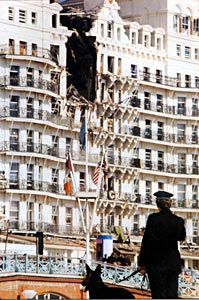8 October 2009 Edition
Remembering the Past: IRA bombs British Cabinet

Grand Hotel, Brighton after the IRA bomb
BY MÍCHEÁL Mac DONNCHATHE year 1984 saw the British government of Margaret Thatcher step up its war in Ireland with greater repression on the streets of the Six Counties, the use of paid perjurers to round up and jail citizens in a form of internment, and the continued murder campaign by Britain’s counter-gangs, the unionist paramilitaries.
In March of that year, Sinn Féin President Gerry Adams and three other republicans were ambushed and shot in their car as they were driving from Belfast Magistrates’ Court. They had been facing charges relating to the attempted seizure by the RUC of a Tricolour carried in a car cavalcade celebrating Gerry Adams’s election as West Belfast MP the previous summer.
Obviously well-informed of the movements of the republicans, the attackers poured shots from three weapons into the car, seriously wounding Gerry Adams, Seán Keenan and Joe Keenan. The attack was claimed by the UFF, the cover-name for the UDA, which was still deemed a legal organisation by the British Government.
In August, the British Government banned the leader of Irish Northern Aid in the United States, Martin Galvin, from visiting the Six Counties. When he appeared at the annual internment anniversary march in Belfast, on 12 August, the RUC attacked the crowd with plastic bullets and killed a civilian, John Downes.
The use of informers as paid perjurers in the courts led to the jailing of scores of people, with one man serving the equivalent of a six-year sentence on remand before being finally released on bail in October 1984.
CONSERVATIVE PARTY CONFERENCE
 Against this background, the IRA campaign continued, despite setbacks such as the seizure of the arms shipment carried on board the fishing trawler, the Marita Ann, skippered by Martin Ferris, at the end of September.
Against this background, the IRA campaign continued, despite setbacks such as the seizure of the arms shipment carried on board the fishing trawler, the Marita Ann, skippered by Martin Ferris, at the end of September.Then, on 12 October, the IRA carried out one of it most audacious attacks when it bombed the British Cabinet which was in the Grand Hotel in Brighton for the Conservative Party conference.
Shortly before 3am, the IRA bomb exploded in the Grand Hotel, blasting out much of the façade and demolishing several rooms. Prime Minister Margaret Thatcher had the narrowest of escapes as her bathroom was destroyed but she was uninjured. Five Tory Party members were killed in the blast.
In its statement the IRA said that Thatcher would “now realise that Britain cannot occupy our country, torture our prisoners and shoot our people on their own streets and get away with it”, adding famously:
“Today we were unlucky, but remember we only have to be lucky once – you will have to be lucky always.
“Give Ireland peace and there will be no war.”
‘THE BRIGHTON BOMBER’
In an interview with the Sunday Business Post in 2000, republican ex-prisoner Patrick Magee, who served a sentence for the bombing and was dubbed by the media ‘The Brighton Bomber’, said that as the British were unable to wipe out the IRA “the long-term strategy was to depict us as criminals while containing the war within the North. As long as the war was kept in that context, they could sustain the years of attrition. But in the early 1980s we succeeded in destroying both strategies. The Hunger Strike destroyed the notion of criminalisation and the Brighton bombing destroyed the notion of containment.”
Magee said he deeply regretted the loss of life “but at the time did the Tory ruling class expect to remain immune from what their frontline troops were doing to us?”
The Brighton bombing took place 25 years ago, on 12 October 1984.


